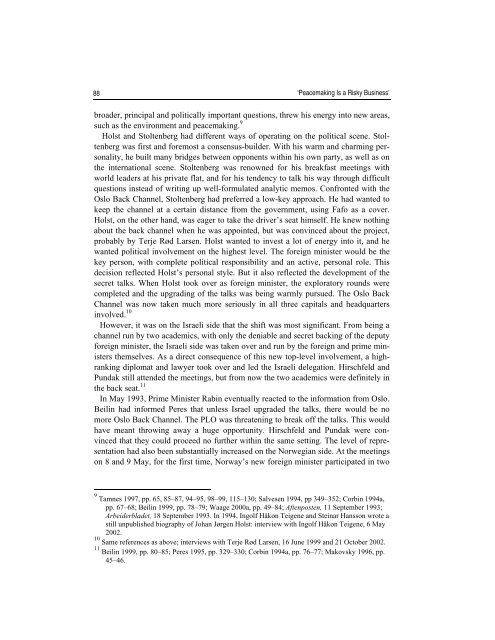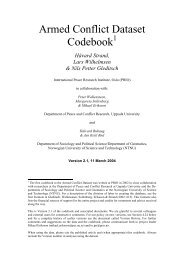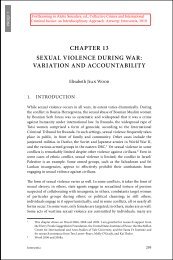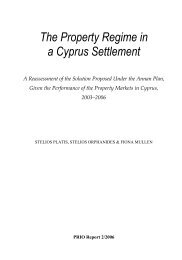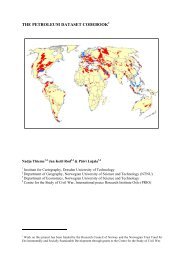Peacemaking Is a Risky Business - PRIO
Peacemaking Is a Risky Business - PRIO
Peacemaking Is a Risky Business - PRIO
Create successful ePaper yourself
Turn your PDF publications into a flip-book with our unique Google optimized e-Paper software.
88 ‘<strong>Peacemaking</strong> <strong>Is</strong> a <strong>Risky</strong> <strong>Business</strong>’broader, principal and politically important questions, threw his energy into new areas,such as the environment and peacemaking. 9Holst and Stoltenberg had different ways of operating on the political scene. Stoltenbergwas first and foremost a consensus-builder. With his warm and charming personality,he built many bridges between opponents within his own party, as well as onthe international scene. Stoltenberg was renowned for his breakfast meetings withworld leaders at his private flat, and for his tendency to talk his way through difficultquestions instead of writing up well-formulated analytic memos. Confronted with theOslo Back Channel, Stoltenberg had preferred a low-key approach. He had wanted tokeep the channel at a certain distance from the government, using Fafo as a cover.Holst, on the other hand, was eager to take the driver’s seat himself. He knew nothingabout the back channel when he was appointed, but was convinced about the project,probably by Terje Rød Larsen. Holst wanted to invest a lot of energy into it, and hewanted political involvement on the highest level. The foreign minister would be thekey person, with complete political responsibility and an active, personal role. Thisdecision reflected Holst’s personal style. But it also reflected the development of thesecret talks. When Holst took over as foreign minister, the exploratory rounds werecompleted and the upgrading of the talks was being warmly pursued. The Oslo BackChannel was now taken much more seriously in all three capitals and headquartersinvolved. 10However, it was on the <strong>Is</strong>raeli side that the shift was most significant. From being achannel run by two academics, with only the deniable and secret backing of the deputyforeign minister, the <strong>Is</strong>raeli side was taken over and run by the foreign and prime ministersthemselves. As a direct consequence of this new top-level involvement, a highrankingdiplomat and lawyer took over and led the <strong>Is</strong>raeli delegation. Hirschfeld andPundak still attended the meetings, but from now the two academics were definitely inthe back seat. 11In May 1993, Prime Minister Rabin eventually reacted to the information from Oslo.Beilin had informed Peres that unless <strong>Is</strong>rael upgraded the talks, there would be nomore Oslo Back Channel. The PLO was threatening to break off the talks. This wouldhave meant throwing away a huge opportunity. Hirschfeld and Pundak were convincedthat they could proceed no further within the same setting. The level of representationhad also been substantially increased on the Norwegian side. At the meetingson 8 and 9 May, for the first time, Norway’s new foreign minister participated in two9 Tamnes 1997, pp. 65, 85–87, 94–95, 98–99, 115–130; Salvesen 1994, pp 349–352; Corbin 1994a,pp. 67–68; Beilin 1999, pp. 78–79; Waage 2000a, pp. 49–84; Aftenposten, 11 September 1993;Arbeiderbladet, 18 September 1993. In 1994, Ingolf Håkon Teigene and Steinar Hansson wrote astill unpublished biography of Johan Jørgen Holst: interview with Ingolf Håkon Teigene, 6 May2002.10 Same references as above; interviews with Terje Rød Larsen, 16 June 1999 and 21 October 2002.11 Beilin 1999, pp. 80–85; Peres 1995, pp. 329–330; Corbin 1994a, pp. 76–77; Makovsky 1996, pp.45–46.


